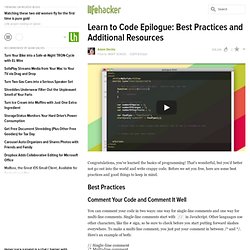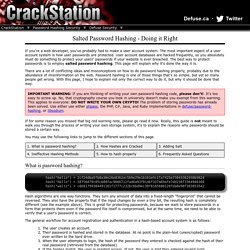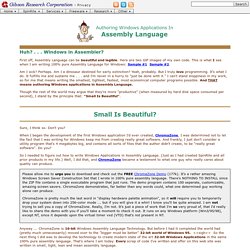

Learn to Code: The Full Beginner's Guide. Learn How to Code Part I: Variables and Basic Data Types. Learn to Code Part II: Working With Variables. @pllee123: Much as I agree with the college classes are a good way to go.

I've been a developer for over five years now and I've never been to a class in my life. It was just curiosity that caught me. I learnt everything I know whilst on the job. I think the most important thing is curiosity. @pllee123: I'm hoping that this will give me a (re-)start in a language again. @pllee123: It doesnt take classes. Back in 1998 we used to joke; what did the high skewl drop out say to the CS major? And now... there are tons of free resources to learn pretty much anything, and forums and chat channels to exploit. Learn to Code Part III: Arrays and Logic Statements. A few tips: (1) You can easily create an array simply by using the literal notation, e.g.: var myArray = ["foo", "bar"]; (2) This might seem like splitting hairs, but unless you're doing some kind of array mutation where this would be sensitive, it is more performant to store the length of the array in another variable before iterating, rather than checking it every time through the loop.

For (var i = 0, len = myArray.length; i < len; i++) { ... } (3) Either your examples are assuming var i was already declared, or you're leaking globals again. Learn to Code Part IV: Understanding Functions and Making a Guessing Game. Learn to Code Epilogue: Best Practices and Additional Resources. Great post.

The bit about comments being even for yourself 6 months from now is so true it's not even funny. Just to clarify (and further stress) why eval in JavaScript is evil: It's not that it just treats a string as a variable per se; it attempts to *execute* any string as JavaScript code. This means that you could put anything that would run in JavaScript into a string, throw it into that function, and it'd run. Why is this evil? For both security and performance reasons. Security, because if you somehow manage to throw some unsanitized user input straight into an eval call, you're basically opening yourself up to a potential world of hurt. Performance, because in order to execute the string passed to eval as code, an additional instance of the JavaScript runtime is fired up to execute it. Also keep in mind, calling setTimeout with a string parameter is equivalent to calling eval; you should pass setTimeout a function instead whenever possible. Function doStuff() { return {
Secure Salted Password Hashing - How to do it Properly. If you're a web developer, you've probably had to make a user account system.

The most important aspect of a user account system is how user passwords are protected. User account databases are hacked frequently, so you absolutely must do something to protect your users' passwords if your website is ever breached. The best way to protect passwords is to employ salted password hashing. This page will explain why it's done the way it is. There are a lot of conflicting ideas and misconceptions on how to do password hashing properly, probably due to the abundance of misinformation on the web. Udacity - 21st Century University. Eloquent JavaScript: A Modern Introduction to Programming (9781593272821): Marijn Haverbeke. Eloquent JavaScript: A Modern Introduction to Programming eBook: Marijn Haverbeke. Peanutty. Assembly Language Windows Applications. Huh?

. . . Windows in Assembler? First off, Assembly Language can be beautiful and legible. Here are two GIF images of my own code. This is what I see when I am writing 100% pure Assembly Language for Windows: Sample #1 Sample #2. Am I sick? Though the rest of the world may argue that they're more "productive" (when measured by hard disk space consumed per second), I stand by the principle that: "Small Is Beautiful". Small Is Beautiful? Sure, I think so. When I began the development of the first Windows application I'd ever created, ChromaZone, I was determined not to let the fact that I was writing for Windows keep me from creating really great software. Security Now! Notes for Episode #109. Brief. CS 142: Web Applications. Course Information. Lectures Lectures are Mondays, Wednesdays, and Fridays from 11:00-11:50 in Building 370, Room 370.

Lecture notes are available in advance and provide an outline for much of the material that will be presented in class; we recommend that you print out the notes and bring them to class so you can mark them up with additional notes during lecture. Books The following textbooks are recommended for the class: The Ruby Programming Language, by David Flanagan and Yukihiro Matsumoto, (O'Reilly Media). These books are well-written and comprehensive. In addition to these books you will also need access to reference documentation on HTML, CSS, and the DOM. Section The class will have a weekly discussion section led by the course assistants. Projects The class will include 8 projects, one due each week except the first week and the week of midterms. Exams The class will have a midterm exam during the sixth week (Oct. 25-29) and a final examination during exams week.
Grading Policy. Lecture Schedule. Projects. Course Staff. Open source. SourceForge - Download, Develop and Publish Free Open Source Software. GitHub - Social Coding. Code University - Google Code. Google Code. Code Playground. Javascript_api_samples.js - google-ajax-examples - This is a placeholder for examples of various Google APIs and their use via JavaScript. Site Directory - Google Code. Teach Me To Code — Writing Code is the Easy Part.
Free Lectures, Screencasts and conferences for real developers & designers. Learn to code. Code Year. W3Schools Online Web Tutorials.